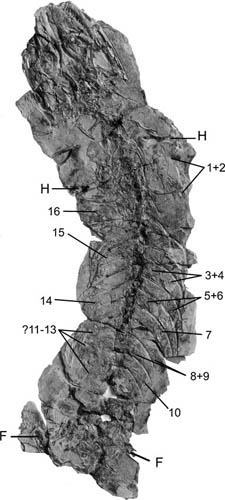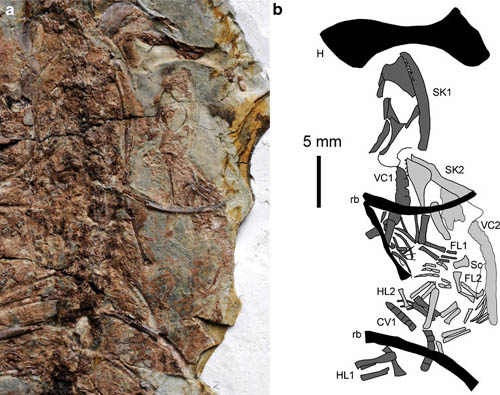| Location: Home > Research > Research Progress |
| A Cretaceous Gravid Lizard Found in China |
|
Although viviparity is most often associated with mammals, roughly one fifth of extant squamate reptiles give birth to live young.However, there is debate as to the antiquity of the trait and, until now, the only direct fossil evidence of squamate viviparity was in Late Cretaceous mosasauroids, specialised marine lizards without modern equivalents. Dr. WANG Yuan, Institute of Vertebrate Paleontology and Paleoanthropology (IVPP), Chinese Academy of Sciences, and Dr. Susan E. Evans, Department of Cell and Developmental Biology, University College London, recently documented viviparity in a specimen of a more generalized, largely terrestrial lizard, Yabeinosaurus tenuis, from the Early Cretaceous of China. The gravid female (IVPP V 18005) contains more than 15 young at a level of skeletal development, as reported online in the scientific journal of Naturwissenschaften (DOI 10.1007/s00114-011-0820-1). The new specimen, IVPP V 18005, was recovered from the Jiufotang Formation in Jianchang County, Liaoning Province. The vertebrate assemblage at this locality also includes Lycoptera fish, pterosaurs and birds and other dinosaurs. V18005 consists of the part and counterpart of a mediumsized lizard (estimated 192 mm snout–pelvis length) with skull, axial skeleton and the proximal parts of the foreand hind limbs. The lizard is about two thirds the size of the largest known individual of Yabeinosaurus and is not fully mature skeletally (long bone epiphyses still separate) but was obviously sexually mature given its gravid condition. Yabeinosaurus was the first lizard to be described from the Chinese Jehol Biota, and it is now relatively well known from both the Yixian Formation (~125 mya) and the overlying Jiufotang Formation (~120 mya). Phylogenetic analyses based on morphological characters place it either on the stem of Scleroglossa or of Anguimorpha. “The gravid female contains more than 15 young at a level of skeletal development corresponding to that of late embryos of living viviparous lizards. This specimen documents the first occurrence of viviparity in a fossil reptile that was largely terrestrial in life, and extends the temporal distribution of the trait in squamates by at least 30 Ma”, said Dr. WANG Yuan, “As Yabeinosaurus occupies a relatively basal position within crown-group squamates, it suggests that the anatomical and physiological preconditions for viviparity arose early within Squamata.” “The presence of viviparity in the Early Cretaceous Yabeinosaurus demonstrates that squamates had evolved the anatomical and physiological adaptations necessary for this reproductive strategy by at least 125 mya, at a time probably not markedly different from that of therian mammals”, said Dr. Susan E. Evans, “Unlike mammals, squamates retained oviparity as their primary reproductive mode, but their ability to switch to viviparity may have contributed to their survival, at least on land, during times of environmental stress.” This work formed part of a joint Anglo-Chinese project funded by the Royal Society, London and the National Natural Science Foundation of China. Field work was also supported by grant 41072015 from the NNSF, China.
Fig. 1: The gravid female Yabeinosaurus (IVPP V 18005, counterpart), showing the positions of the embryos (numbered) and the humeri (H) and femora (F) of the adult. (Image by WANG Yuan)
Fig. 2 Close-up of the anterior pectoral region of IVPP V 18005. a Photograph, b line drawing showing humerus and ribs of the mother in black and two embryos (1, 2) in different shades of grey. (Image by WANG Yuan) |

